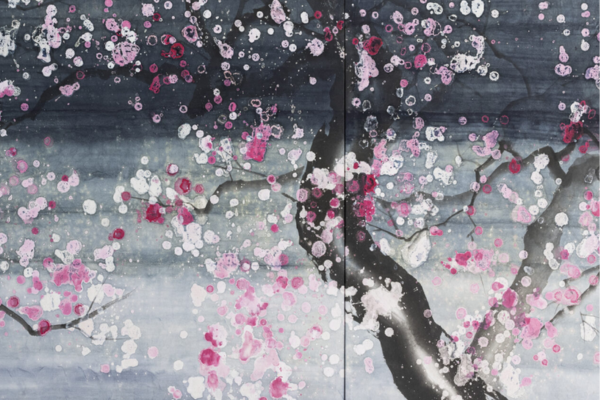Japanese Painting: A Reflection of Nature
The Japanese painting, particularly the Sumi-e, has always had a strong connection with nature. From the mist-soaked mountains to the delicate petals of cherry blossoms, nature permeates every brushstroke, providing not only the subject but also the underlying inspiration and philosophy in this art form.
Artists of Japanese painting do not merely replicate nature in terms of physical appearance. Rather, they seek to capture the essence of nature, its energy, and spirit. This understanding goes beyond the aesthetic to encompass a deep reverence for life in all its forms and an appreciation of its inherent interconnectedness.
Nature as a Theme in Japanese Painting
The “Four Gentlemen”
In Japanese painting, the “Four Gentlemen”, the plum, the orchid, the bamboo, and the chrysanthemum, have been revered for centuries for their beauty and symbolism. Each of these natural themes represents different virtues and aspects of the spiritual path. For instance, bamboo symbolizes resilience and flexibility, the ability to withstand adversities without breaking.
Landscapes and Animals
In addition to plants, landscapes, and animals are common themes in Japanese painting. Mountains, rivers, and forests are not merely depicted as static elements of the landscape but as living beings that breathe, change, and evolve over time.
Animals, on the other hand, are appreciated for their unique character and spirit, which artists aim to capture in their paintings. A soaring hawk, for example, may represent freedom and aspiration, while a resting cat may symbolize peace and tranquility.
The Philosophy of Nature in Japanese Painting
The Influence of Zen
Zen philosophy has had a significant influence on the Japanese painting. With its emphasis on meditation and mindfulness, Zen teaches that all beings and objects in the universe are interconnected. This concept is reflected in Japanese painting, where the relationship between the artist and nature is one of mutual respect and harmony.
Wabi-sabi and the Beauty of Imperfection
Another important concept in Japanese painting is wabi-sabi, an aesthetic philosophy that sees beauty in imperfection and the transience of nature. Instead of striving for perfection, artists of Japanese painting aim to capture the unique charm and ephemeral beauty of their subject. A tree with twisted branches or a fallen leaf, for example, can be seen as beautiful in their own right, reflecting the natural cycle of life and death.
Techniques Inspired by Nature in Japanese Painting
The Use of Ink
Ink, or sumi, is one of the main materials used in Japanese painting. Through careful variation of the ink’s density, artists can recreate a range of tones and textures that reflect the diversity and richness of nature.
The Power of Blank Space
Blank space, or ma, is another crucial element in Japanese painting. Far from being merely an empty space, ma is an integral part of the composition that provides balance and highlights the painted elements. In this sense, ma can be seen as a reflection of nature, where space and silence are as important as physical objects and sound.
In conclusion, nature plays an integral role in the Japanese painting, providing not only the subject but also the underlying inspiration and philosophy of this art form. Through their appreciation of nature, artists of Japanese painting invite us to see the world with new eyes and recognize the beauty and interconnectedness in all things.



